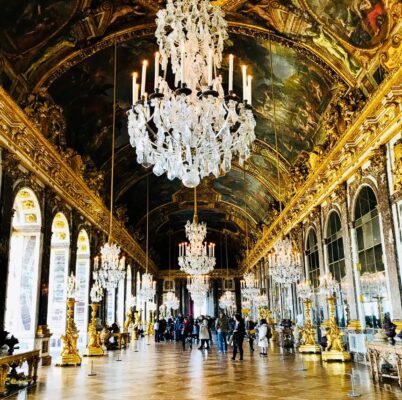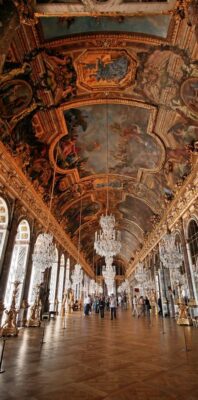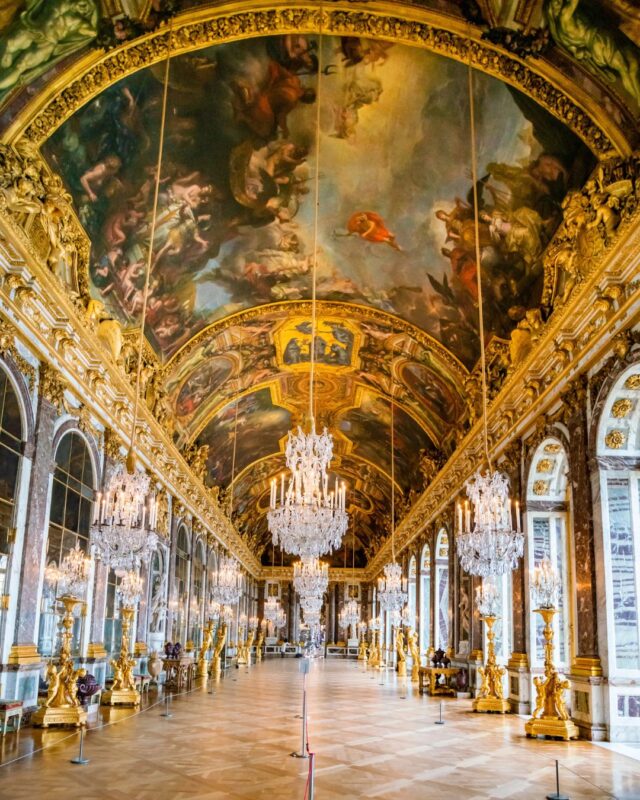The Hall of Mirrors, one of the most renowned rooms in the Palace of Versailles, is a masterpiece of art, architecture, and history. Stepping into this breathtaking gallery is an experience that no photograph can truly capture. Follow archeology.dulichvn.net to discover many hidden mysteries that have yet to be discovered.

A Symbol of Royal Grandeur: The Hall of Mirrors
The Hall of Mirrors in the Palace of Versailles is not merely an architectural wonder but a living testament to the grandeur and ambition of the French monarchy. This iconic gallery encapsulates the opulence, artistry, and historical significance of the 17th and 18th centuries.
A Regal Connection
Constructed during the reign of Louis XIV, also known as the “Sun King,” the Hall of Mirrors served as a bridge between the King’s apartments and the Queen’s quarters. This physical connection symbolized the unity and power of the royal court, emphasizing the central role of monarchy in French life.
A Venue of Celebration
The Hall was not just a corridor but a stage for significant royal milestones. One of its most memorable moments was the wedding celebration of Marie Antoinette and Louis XVI, an event that united two of Europe’s most powerful dynasties.
Witness to History
Beyond its royal functions, the Hall of Mirrors has been a backdrop to world-changing events. It was here, in 1919, that the Treaty of Versailles was signed, officially ending World War I and reshaping global geopolitics.

Artistry and Craftsmanship of the Hall of Mirrors
The Hall of Mirrors at the Palace of Versailles stands as a testament to the unparalleled artistry and craftsmanship of its creators. Every element of this iconic space reflects the grandeur and vision of 17th-century France, combining architectural brilliance, exquisite decoration, and innovative design.
The Visionary Designer
The Hall of Mirrors was conceived by Jules Hardouin-Mansart, one of the most celebrated architects of his time. Mansart’s genius is evident in the hall’s impeccable balance and symmetry. Spanning an impressive 73 meters, the gallery’s proportions harmonize with the rest of the palace, embodying the ideals of Baroque architecture.
Baroque Grandeur
This architectural masterpiece exemplifies Baroque design with its dramatic scale, ornate details, and focus on creating awe-inspiring spaces. The integration of light and reflection in the Hall of Mirrors enhances its opulent atmosphere, leaving visitors mesmerized.
Connection to the Palace
Strategically situated, the Hall of Mirrors connects the King’s apartments to the Queen’s quarters. This placement underscores its importance as a central space for both royal functions and ceremonial events.

A Must-Visit Destination: The Hall of Mirrors
The Hall of Mirrors, located within the iconic Palace of Versailles, is more than just a masterpiece of architecture and art—it is a journey through the grandeur of France’s royal history. From its cultural significance to the breathtaking experience it offers, this historic gallery remains a must-visit destination for travelers worldwide.
A Testimony to Royal Grandeur
The Hall of Mirrors stands as an enduring symbol of the lavishness and artistic brilliance of the French monarchy. Commissioned by Louis XIV, it reflects the height of his reign, a period when France was a global power in politics, culture, and art.
An Icon of Historical Significance
The gallery is not just a visual marvel; it is steeped in history. Key moments, such as the signing of the Treaty of Versailles in 1919, took place here, making it a cornerstone in world history and diplomacy.
A Cultural Magnet
Drawing millions of visitors each year, the Hall of Mirrors is celebrated for its intricate design, reflecting the artistic and cultural zenith of the Baroque period. It continues to inspire awe and admiration, serving as a testament to France’s artistic legacy.
See more: The Enigmatic 100-Room Abandoned Mansion: A Journey Through Time
Conclusion
The Hall of Mirrors is more than just an architectural marvel; it is a timeless symbol of French art, history, and royalty. From its stunning mirrors and ceiling paintings to its role in pivotal historical events, this iconic gallery continues to captivate all who enter its splendor. Visiting the Hall of Mirrors is a journey into the grandeur of France’s golden age, a must-see for anyone exploring the treasures of Versailles.


CÁC TIN KHÁC
Mary Walton: The Forgotten Inventor Who Helped Clean Up America’s Cities
Tomb of Queen Nefertari in the Valley of the Queens, Egypt
Discover the Hypostyle Hall of the Temple of Hathor at Dendera
Venus de Losange: Unveiling the Mystery of a 20,000-Year-Old Paleolithic Icon